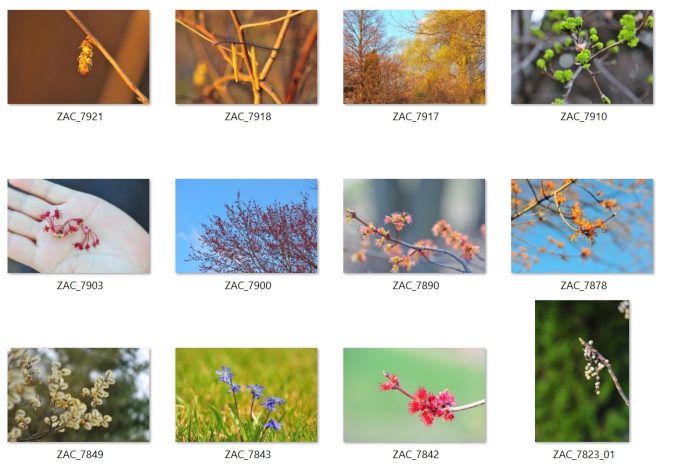Most photos taken Saturday, 4/3/2010, Okemos, Michigan. Others taken earlier are noted.
Saturday afternoon, my wife took me to Walmart. Not interested in shopping, I stood outside observing maple flowers, hoping to see a honey bee foraging on them. I did not bring my camera though. I saw lots of bees, but all seemed to be solitary (probably halictid or andrenid bees). Then I noticed something interesting: some trees have all female flowers that are more red, and others have male flowers only, and one tree I saw mixed flowers. I had to call Prof. G. Ayers, an world expert in bee plants. He said, yes, this is technically called polygamo-dioecious, meaning they can have it all: plants with only males, only females, and some with both. I never observed red maple flowers so closely, so I learned something today when I did! I went back home, picked the camera, and came to the same spot and took some photos.
1. Red maple, female flowers (March 31)
2. Red maple, male flowers
3. Red maple, a “perfect flower” (with both female and male parts) and one on the right side, next to it (a male).
4. Red maple, female flowers, with a bee, probably a halictid (sweat bee).
5. Then I checked some of my silver maple photos, I think they are also polygamo-dioeciou. This one showing flowers with both stigma (red) and stamens (long white stalk with pollen at end). The older flowers in the background: I am not sure they are males only, or the sigma was receding and hidden. Taken March 24, front of admin building, MSU campus.
6. Evening of the same day, we took a walk in Okemos and saw more maple trees:
red maple, female tree
7. Too high to get close shots, but my wife picked some flowers under the tree. Indeed, the redder tree is usually all female.
8. Red maple, male flowers. they looked more pinkish.
9. A maple that I thought is red maple, but more yellowish in appearance. April 4, 2010
10. Box-elder, also a maple (Acer negundo)
11. Another type of maple, to be identified..(Joe Riddle says this should be a Norway maple).
12. Pussy willow was blooming, waited for 5 min, no bees, but did see many honey bees a few weeks earlier. They were too high and far away to photograph though.
13. A closeup
14. Pussy willow, March 31. I remember seeing honey bees that day (but too far to tell). I did have shots of honey bees foraging on it a few years back.
15. poison oak (Poison ivy) seeds (from a different walk, March 31)
16. Hazelnut male flowers. These were wild, growing along the roadside on Dobie road. The nuts tasted the same but much smaller than the cultivated ones.
17. Hazelnut female flowers
18. Far away, I can see a willow tree becoming all green.
19. A daffodil ready to open, in front of the old Edgewood Elementary school, now used a daycare after the school was closed a few years back.
20. Scilla, planted by my wife in my front lawn, the crocuses are gone and they are happily blooming.
21. Forsythia, have seen one honey bee foraging on this flower in the campus of Australia National University, will see if I can find that photo!
It is funny that once I pay more attention, I saw maple trees everywhere! Mostly red maples (and females), as the silver maples bloomed earlier. If you take the time to observe nature closely, life will be more beautiful?
Original posted on April 4, 2010.
updated on March 19, 2023. Here is what I did today:
*******
Here are the steps to re-create the links:
1. find the original files, copy the needed one according to those linked to in the blog
2. convert from raw to jpg files, resize them down to 1800 pixels the widest dimension
3. upload to website
4. copy the code to notepad.
5. replace the code of
http://lh6.ggpht.com/_rP8_lOb93UE/S7jJaSkoy2I/AAAAAAAAGfM/ME0YfFoVMvU/ZAC_7852.jpg
to
http://lh/ZAC_7852.jpg
Have to do it by hand because the picasa links were random. on ggpht.com renamed the same in the whole link.
6. globally change the url to the correct one, and rename the jpg files
7. check each image is linked fine.
8. This only took about 1 hour to do.


your bee pollination dependence factor chart is confusing. i was reading it to say that bees are only responsible for 0.9% of cherry pollination.
****
Submitted on 2010/04/14 at 7:14pm
no. 0.9=90%.
Zachary